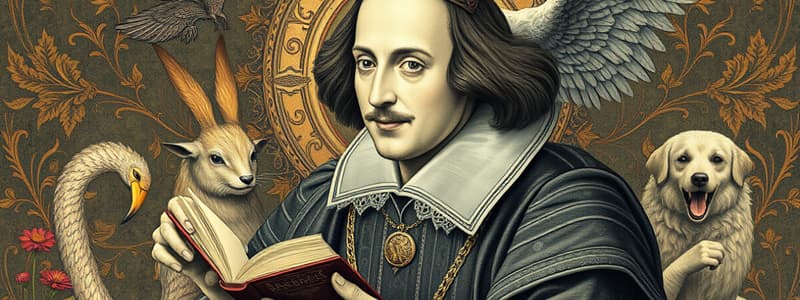Podcast
Questions and Answers
What does Shakespeare's use of animal imagery primarily help the audience understand?
What does Shakespeare's use of animal imagery primarily help the audience understand?
- The worst parts of human nature. (correct)
- The importance of loyalty in family relationships.
- The motivations behind characters' actions.
- The beauty of nature.
How does the imagery of clothing contribute to the overall themes in Shakespeare's work?
How does the imagery of clothing contribute to the overall themes in Shakespeare's work?
- By contrasting fantasy with realism.
- By showcasing the elegance of the nobility.
- By highlighting the comedic elements.
- By emphasising the theme of appearance versus reality. (correct)
What is the significance of the phrase 'Poor, bare, forked animal' in Lear's journey?
What is the significance of the phrase 'Poor, bare, forked animal' in Lear's journey?
- It compares humans to animals in a humorous way.
- It symbolises his wealth and power.
- It highlights his transformation and vulnerability. (correct)
- It illustrates his disdain for other creatures.
What does the term 'gilded butterflies' suggest about the court?
What does the term 'gilded butterflies' suggest about the court?
How is the imagery of sight and blindness used in the play?
How is the imagery of sight and blindness used in the play?
What does Lear's action of throwing off his clothing represent?
What does Lear's action of throwing off his clothing represent?
What is the significance of tears in the play?
What is the significance of tears in the play?
What does the Fool suggest about human nature through the line 'fathers that bear bags shall see their children kind'?
What does the Fool suggest about human nature through the line 'fathers that bear bags shall see their children kind'?
Which character expresses the quote 'I have no way, and therefore want no eyes'?
Which character expresses the quote 'I have no way, and therefore want no eyes'?
What does the phrase 'poor naked wretches' signify?
What does the phrase 'poor naked wretches' signify?
What does the imagery of clothing in the play often signify?
What does the imagery of clothing in the play often signify?
In the quote, 'I am ashamed that thou hast power to shake my manhood thus,' what does Lear imply about Goneril's influence over him?
In the quote, 'I am ashamed that thou hast power to shake my manhood thus,' what does Lear imply about Goneril's influence over him?
What is the emotional impact of Lear's tears on the audience?
What is the emotional impact of Lear's tears on the audience?
Flashcards are hidden until you start studying
Study Notes
Animal Imagery
- Shakespeare's use of animal imagery exposes the darker aspects of human nature.
- Lear describes Goneril and Regan with harsh animal comparisons, emphasising their inhuman qualities.
- Important quotes include references to "marble-hearted fiends", "sharper than a serpent's tooth", and "monster ingratitude".
- Lear recalls a "pelican" metaphor, suggesting parental sacrifice and betrayal.
- Albany refers to "tiger’s not daughters" to denote their ferocity.
- The Fool’s analogy of the hedge-sparrow and cuckoo illustrates the dangers of blind nurturing.
- Lear’s journey includes a sense of vulnerability; met with imagery like "poor, bare, forked animal" indicating loss and suffering.
- Contrast between anguish and brief hope during Lear's redemption arc.
Clothing Imagery
- Clothing represents the theme of appearance versus reality throughout the play.
- “Gilded butterflies” symbolises superficiality prevalent in the hypocritical court.
- “Gilded serpents” illustrate deception concealed by outward appearances.
- The Fool comments on society’s corruption by valuing wealth over character using clothing metaphors.
- "Poor naked wretches" underlines the plight of the vulnerable who lack material possessions.
- Lear's act of shedding robes signifies a rejection of his former identity and influences.
Sight and Blindness Imagery
- Imagery of sight and blindness permeates the play, shedding light on the themes of insight through blindness.
- Key phrases include “Out of my sight” and “See better Lear”, demonstrating the struggle for clarity.
- Gloucester’s statement about blindness reflects the deeper metaphorical blindness regarding understanding and mistakes.
- Lear’s confusion about his hands symbolises losing touch with reality.
- Cordelia’s plea for Lear to look upon her signifies a desire for recognition and understanding.
- The interplay of sight and blindness depicts the struggles of misguided authority and wisdom.
Tears as a Symbol of Weakness
- Lear's tears symbolise his loss of masculinity and emotional vulnerability.
- Important lines express Lear's shame in showing emotion, indicating a perceived weakness.
- References to "old fond eyes" and curses involving tears highlight the fragility of human dignity.
- Emotional expressions through tears create a poignant connection with the audience, evoking sympathy.
Tears as a Symbol of Weakness in King Lear
- Tears signify Lear's emotional vulnerability and loss of power.
- Shakespeare evokes pathos in the audience through Lear's struggle with masculinity.
- Lear's lamentation reveals shame over being emotionally affected by Goneril, as expressed in his dialogue.
- The quote highlights Lear's admission of feeling emasculated: “I am ashamed that thou hast power to shake my manhood thus.”
- Lear equates his tears with a loss of manhood, suggesting that vulnerability is perceived as weakness.
- In an angry outburst, Lear curses Goneril, linking her to future suffering with a child who will provoke her tears.
- The imagery of “cadent tears” accentuates the physical manifestation of grief, reinforcing Lear's emotional turmoil.
- Lear's conflict between stoicism and emotional expression illustrates the tension between societal expectations of masculinity and personal anguish.
Studying That Suits You
Use AI to generate personalized quizzes and flashcards to suit your learning preferences.




